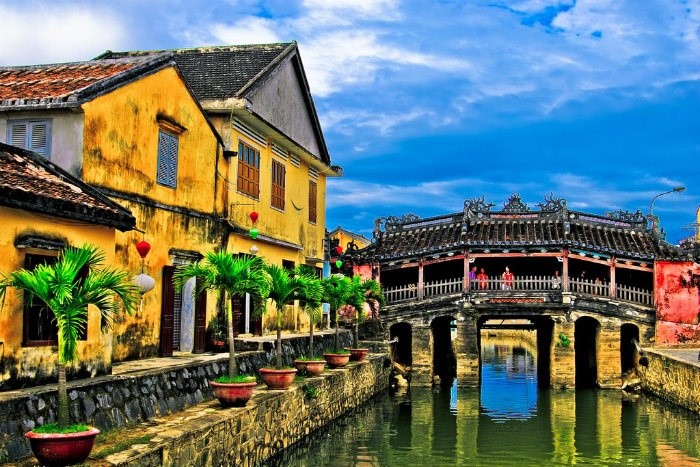Destination
Hoi An
Lying on the banks of the Thu Bon River, Quảng Nam province ( in the South Central Coast of Vietnam), Hoi An Ancient Town is an exceptionally well-preserved example of a South-East Asian trading port dating from the 15th to the 19th century. The architecture in Hoi An is characterized by a harmonious blend of Vietnamese, Chinese and Japanese culture. Its buildings and its street plan reflect the influences, both indigenous and foreign, that have combined to produce this unique heritage site.
There are a lot of interesting thing for you to do in Hoi An. It is home to some of the most beautiful hotels and resorts in the world. You can stay closer to town or in the rice paddies with nature. Hoi An is ideal for bicycle, beach and boat-cruise trips. Hoi An is great holiday destination.

The culture & heritage that UNESCO World Heritage Site status for Hoi An Ancient Town was trying to preserve has long since gone. Since 1999, when UNESCO WHS status was awarded, there has been a massive increase in tourism – with the result that most houses have been sold by the community to speculators and shop owners to be used for commercial purposes. The former community, and with it their culture and heritage, has gone and in their place are endless indistinguishable shops, restaurants, art galleries, etc. There are literally hundreds of tailor shops in Hoi An.
Once purchased, the old town ticket (120,000 dong) includes five coupons that can be used to enter five attractions of your choosing: museums, old houses, assembly halls, the handicraft workshop (and traditional music show) or the traditional theatre, and either the Japanese Covered Bridge or the Quan Cong Temple. Tickets are sold at various entry points into the Old Town, including Hai Ba Trung Street, and also at some of the attractions, including the Cantonese Assembly Hall. The city requests that visitors dress “decently” while visiting sites in the Old Town. Men should wear a shirt and women shouldn’t wear bikini tops, sleeveless blouses or skirts above the knees. Respect the local culture and remember that you are not on the beach.
- Japanese Covered Bridge’s Pagoda (Chua Cau or Lai Vien Kieu). The Bridge is located on the west end of Tran Phu Street, but the ticket is ONLY required to access the annexed pagoda on one side of the bridge’s interior; the bridge itself is free for crossing. The bridge was constructed in the early 1600’s by the Japanese community, roughly 40 years before they left the city to return to Japan under the strict policy of sakoku enforced by the Tokugawa Shogunate, and renovated in 1986. Today, it’s the symbol of Hoi An.
- Precious Heritage Museum, 26 Phan Boi Chau. A 250m2 display of photos and artifacts collected by Réhahn during the past 5 years of the french photographer’s explorations of Vietnam. Free Entrance.
- Quan Cong Temple, 24 Tran Phu Street.

The ticket allows admission to four museums in the Old Town (one ticket-one museum):
- Museum of Folk Culture, 33 Nguyen Thai Hoc Street. Some may be put off by the bizarre-looking plaster sculptures of Vietnamese peasants, but this museum documents the dress and culture of rural Vietnam.
- Museum of Trade Ceramics, 80 Tran Phu Street. The dusty, unlabeled displays of broken pottery are eminently forgettable, but the house itself is nice enough, and it provides a better opportunity to explore the shape and layout of an old Hoi An home than you’ll find at any of the Old Houses (below).
- Hoi An Museum of History and Culture, 7 Nguyen Hue Street. The museum contains some old black and white photos of Hoi An taken in the early 20th century. It also houses an old canon, some two-thousand year old pots from the Sa Huynh period, and a case full of 9th century bricks and tiles from the Champa period.
- Museum of Sa Huynh Culture, 149 Bach Dang Street. The museum’s main collection consists of pottery and urns from the 1st and 2nd centuries. Upstairs, there used to be another museum, the Museum of the Revolution. Its main collection consists of pictures from war heroes and a collection of weapons such as grenade launchers, machine guns and AK47s. However, this collection has now been relocated to the new museum building at the top of Le Loi Street, and is not currently open to the public.
There are three old houses that exist in an awkward halfway state between museum show-piece and somewhat shabby residence for the family that lives there.
- Phung Hung House, 4 Nguyen Thi Minh Khai Street, just west of the Japanese Bridge. Traditional two-story wooden house, inhabited over 100 years by eight generations; and the current one attempts to guide you around in hope of a tip.
- Quan Thang House, 77 Nguyen Thai Hoc Street.
- Tan Ky House, 101 Nguyen Thai Hoc Street. As above, a younger member of the family will provide a cup of tea and a “tour” that doesn’t stray from the front room of the house, as you’d need to step over sleeping members of the older generation to go anywhere else. The design of the house shows how local architecture incorporated Japanese and Chinese influences. Japanese elements include the crab shell-shaped ceiling supported by three beams in the living room. Chinese poems written in mother-of-pearl are hanging from a number of the columns that hold up the roof.
Go to topasiatravel.net for more useful information about Vietnam tours with Top Asia Travel

Hotline: 0931.939.888 – 0985.339.888
Email: info@topasiatravel.com.vn


